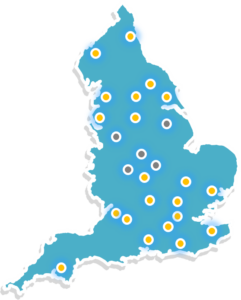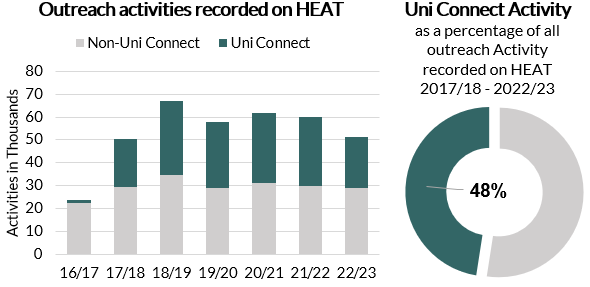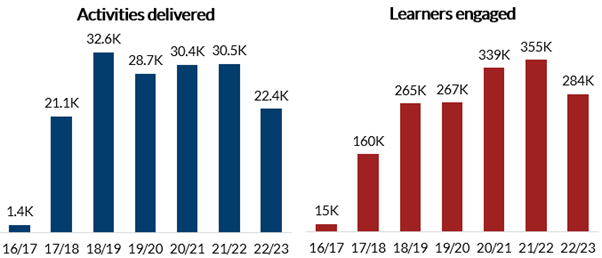Uni Connect impact on HE Progression
In this section, we explore the entry rates of Uni Connect participants who were expected7 to enter HE in 2020/21, and who did so by 2021/22. These learners will have had a maximum of three full years of engagement in Uni Connect activity (Table 1).8 Learners who took part in Uni Connect activity in earlier year groups are yet to be tracked into HE.
|
2016/17
|
2017/18
|
2018/19
|
2019/20
|
2020/21
|
2021/22
|
Cohort
|
Cohort in
Year 10 |
Cohort in
Year 11 |
Cohort in Year 12
or FE equivalent |
Cohort in Year 13
or FE equivalent |
Cohort may enter
HE by age 18 |
Cohort may enter
HE by age 19 |
Uni Connect
|
Starts in
Summer 2017 |
Cohort engaged
for 1 year max. |
Cohort engaged
for 2 years max. |
Cohort engaged
for 3 years max. |
|
|
Table 1: Timeline of Participation in Uni Connect activity in expected HE progression
All Students engaged in Uni Connect outreach
First, we explore the HE Progression of all students engaged in Uni Connect activity, regardless of whether they live in an area targeted by the Uni Connect Programme.
Tracking school students engaged in an intensive package of Uni Connect outreach activities into HE shows that they were 14.1 percentage points more likely to enter HE than a closely matched comparison group of students who received little to no Uni Connect outreach (Figure 4). This gap, which was found to be statistically significant, suggests that participating in an intensive package of Uni Connect outreach while in school may have a positive impact on progression to HE within two years of being expected to enter.
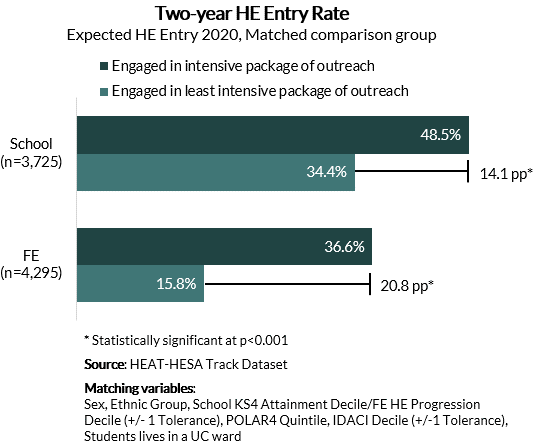
Figure 4: Two-year HE Entry Rates of School and FE students in receipt of Uni Connect activity
Tracking FE students9 engaged in an intensive package of Uni Connect outreach activities into HE shows that they were 20.8 percentage points more likely to enter HE than a closely matched comparison group of FE students who received little to no Uni Connect outreach. The large gap between entry rates of FE students who participated in an intensive package of outreach to those who did not was found to be statistically significant and those in receipt of an intensive package of outreach in this subgroup were therefore more than twice as likely to enter HE than their counterparts in receipt of little to no outreach. This gap suggests that FE students may particularly benefit from participation in an intensive package of outreach.
Students in receipt of an intensive package of Uni Connect outreach from both types of institutions, schools and FE colleges, are more likely to progress to HE within two years than those in receipt of little to no Uni Connect outreach. This suggests that the Uni Connect Programme is contributing to reducing the gap in HE participation between the most and least represented groups by contributing to increased progression to HE of its outreach participants.
Students engaged in Uni Connect outreach who live in Uni Connect target areas
Secondly, we explore the impact of Uni Connect on the most disadvantaged students. These are learners who live in areas specifically targeted by the Uni Connect Programme due to their low HE progression rates.
Using the same closely matched comparison groups as above, the data shows that those school students in receipt of an intensive package of outreach, who live in a Uni Connect target area, were 13.3 percentage points more likely to enter HE than their peers in a closely matched comparison group living in Uni Connect target areas who received little to no Uni Connect outreach (Figure 5).
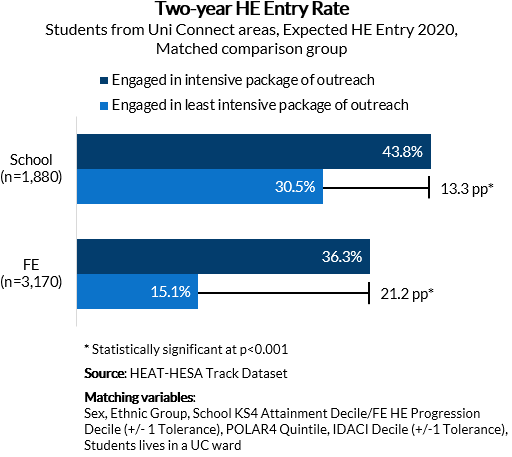
Figure 5: Two-year HE Entry Rates of School and FE students, who live in Uni Connect target areas, in receipt of Uni Connect activity
FE students who live in Uni Connect target areas and were in receipt of an intensive package of outreach were 21.1 percentage points more likely to enter than their peers in receipt of little to no Uni Connect outreach.
These findings suggest that outreach delivered by Uni Connect partnerships is effective in supporting those learners in the most disadvantaged areas, in line with the priorities of the Uni Connect programme, suggesting a contribution to increasing HE progression where it is needed the most.
Overall, it can be concluded that engagement in intensive Uni Connect activity has been beneficial to HE progression of both school and college learners and for both the overall cohort and for learners in target areas.
With learners who were in engaged in more than one year of Uni Connect activity pre-16 yet to be tracked into HE, we look forward to exploring the impact of even more sustained and progressive programmes, implemented over time, in future analyses.
Return to Introduction
 Between 2017/18 and 2022/23, almost half of the outreach activities recorded on HEAT were delivered by, or in partnership with, Uni Connect partnerships.
Between 2017/18 and 2022/23, almost half of the outreach activities recorded on HEAT were delivered by, or in partnership with, Uni Connect partnerships. Students who take part in an intensive package of Uni Connect activity consisting of at least eight contact hours are up to 21 percentage points more likely to enter higher education than a closely matched group of students who took part in less than three hours of Uni Connect outreach.*
Students who take part in an intensive package of Uni Connect activity consisting of at least eight contact hours are up to 21 percentage points more likely to enter higher education than a closely matched group of students who took part in less than three hours of Uni Connect outreach.* The higher education entry gap is particularly pronounced for further education learners who live in Uni Connect target areas; those in receipt of an intensive package of Uni Connect activity were more than twice as likely to enter higher education than a closely matched comparison group.
The higher education entry gap is particularly pronounced for further education learners who live in Uni Connect target areas; those in receipt of an intensive package of Uni Connect activity were more than twice as likely to enter higher education than a closely matched comparison group.
